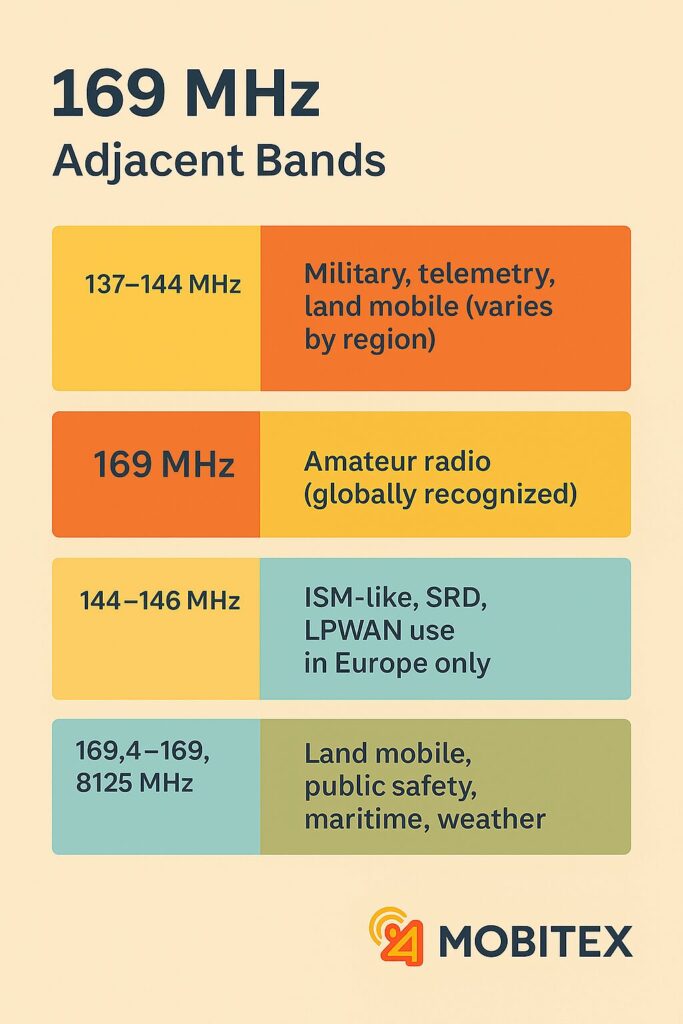The 169 MHz frequency is a part of the VHF spectrum , situated just above traditional land mobile and amateur allocations. Once used primarily for pager systems in Europe, it has evolved into a powerful niche for low-power, wide-area (LPWA) communications , especially in smart metering , utility monitoring , and IoT applications.
Though limited in bandwidth, the 169 MHz band offers excellent propagation characteristics , making it ideal for deep indoor and long-range rural coverage where higher frequencies struggle.
Center Frequency : 169.000 MHzCommon Operating Band : 169.4–169.8125 MHzBand Class : VHF (Very High Frequency)ITU Allocation : Primarily Region 1Channel Width : Narrowband (12.5 kHz typical)
🌐 Region Frequency Allocation Primary Use Licensing 🌍 Region 1 (Europe, Africa) 169.4–169.8125 MHz (ETSI ERC Rec 70-03 Annex 1) IoT / Smart Metering / Telemetry License-exempt (Class 1 SRD) 🌎 Region 2 (Americas) No harmonized use Used for land mobile / experimental Licensed / conditional 🌏 Region 3 (Asia-Pacific) Varies by country (some use for paging or telemetry) Licensed narrowband use Licensed or unallocated
✅ Harmonized use in Region 1 , particularly within the EU under SRD Class 1 rules
Application Description Smart Utility Metering Water, gas, and electricity meter reading in hard-to-reach areas Wireless M-Bus (EN 13757-4) Standardized protocol for meter communication Environmental Sensors River level monitors, air quality, and pollution tracking Infrastructure Monitoring Oil/gas pipelines, dams, bridges, and flood defense systems Building Automation Alarms, HVAC, elevator telemetry, smoke detectors Paging Systems (legacy) Still used in some areas for public safety and hospital alerts
Region 1 (Europe) :
License-exempt use under ETSI SRD Class 1
Up to 500 mW ERP , duty cycle limits apply (typically <10%)
Operates under ERC Rec 70-03 , Annex 1
Other regions :
Use not harmonized; may require special licenses or not be available
Parameter Typical Values Max Power (ERP) 500 mW (Region 1) Modulation Types FSK, GFSK, 2GFSK (typically narrowband) Bandwidth 12.5 kHz (typical); up to 25 kHz Link Range Up to 20 km rural, 2–3 km urban, 1 km indoor
Europe :
ETSI EN 300 220 governs emissions, coexistence, and spectrum etiquette
Operates under a non-protection, non-interference basis
Rest of world :
Check national allocations; may conflict with other services
Band Frequency Range Use 137–144 MHz Military, telemetry, land mobile (varies by region) 144–146 MHz Amateur radio (globally recognized) 146–174 MHz Land mobile, public safety, maritime, weather 169.4–169.8125 MHz ISM-like, SRD, LPWAN use in Europe only
Low interference risk due to niche adoption
Band relatively quiet , which improves signal integrity
Interference could occur from adjacent amateur or land mobile services in poorly filtered systems
Some regions still use paging systems , which may overlap or conflict
Previously used for ERMES paging systems in Europe
Declined with cellular paging’s collapse, reallocated for SRD and IoT use
Became a focal point for wireless M-Bus and LPWAN standardization in smart metering
Excellent building penetration at 169 MHz makes it suitable for smart grid applicationsWorks well with simple antennas ; easier to match and tune at VHF
Suitable for long-range, low-power applications with tight bandwidth budgets
Often integrated with EN 13757 / OMS stack in utilities
Wireless M-Bus (169 MHz mode)
LPWAN (non-LoRa, ETSI-compliant)
ETSI EN 300 220, EN 13757-4 (standard frameworks)
Smart Utility Metering Platforms (Sensus, Elster, Itron)
Attribute Value/Details Center Frequency 169 MHz ITU Region Use Primarily Region 1 Primary Use Smart metering, IoT, telemetry License Required? No (Region 1, SRD use only) Typical Power Up to 500 mW ERP Modulation Types FSK, GFSK Harmonized? Partially (Region 1 only) Key Benefit Deep penetration, long range, low interference

